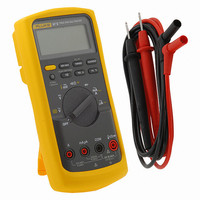FLUKE-87-5 Fluke Electronics, FLUKE-87-5 Datasheet - Page 11

FLUKE-87-5
Manufacturer Part Number
FLUKE-87-5
Description
DMM INDUSTRIAL TRUE-RMS W/TEMP
Manufacturer
Fluke Electronics
Series
8xr
Type
Digital (DMM)r
Specifications of FLUKE-87-5
Includes
Battery, Clips, Temperature Probe, Test Leads
Style
Handheld
Display Digits
4.5
Display Type
LCD, Bar Graph
Display Count
20000
Function
Voltage, Current, Resistance, Capacitance, Temperature, Frequency
Functions, Extra
Continuity, Diode Test
Features
Auto Off, Backlight, Clips, Hold, Min/Max/Ave
Ranging
Auto/Manual
Response
True RMS
Lead Free Status / RoHS Status
Vendor undefined / RoHS compliant by exemption
Other names
2074974
614-1042
87 V
87-5
87-V
FLUKE 87 V
FLUKE-87-V
614-1042
87 V
87-5
87-V
FLUKE 87 V
FLUKE-87-V
Inspect the test leads for damaged
insulation or exposed metal. Check the
test leads for continuity. Replace
damaged test leads before you use the
Meter.
Do not apply more than the rated
voltage, as marked on the Meter,
between the terminals or between any
terminal and earth ground.
Never operate the Meter with the cover
removed or the case open.
Use caution when working with voltages
above 30 V ac rms, 42 V ac peak, or 60 V
dc. These voltages pose a shock hazard.
Use only the replacement fuses specified
by the manual.
Use the proper terminals, function, and
range for measurements.
Avoid working alone.
When measuring current, turn off circuit
power before connecting the Meter in the
circuit. Remember to place the Meter in
series with the circuit.
When making electrical connections,
connect the common test lead before
connecting the live test lead; when
disconnecting, disconnect the live test
lead before disconnecting the common
test lead.
Do not use the Meter if it operates
abnormally. Protection may be impaired.
When in doubt, have the Meter serviced.
Do not operate the Meter around
explosive gas, vapor, or dust.
Use only a single 9 V battery, properly
installed in the Meter case, to power the
Meter.
When servicing the Meter, use only
specified replacement parts.
When using probes, keep fingers
behind the finger guards on the
probes.
Do not use the Low Pass Filter option to
verify the presence of hazardous
voltages. Voltages greater than what is
indicated may be present. First, make a
voltage measurement without the filter to
detect the possible presence of
hazardous voltage. Then select the filter
function.
Safety Information
3










